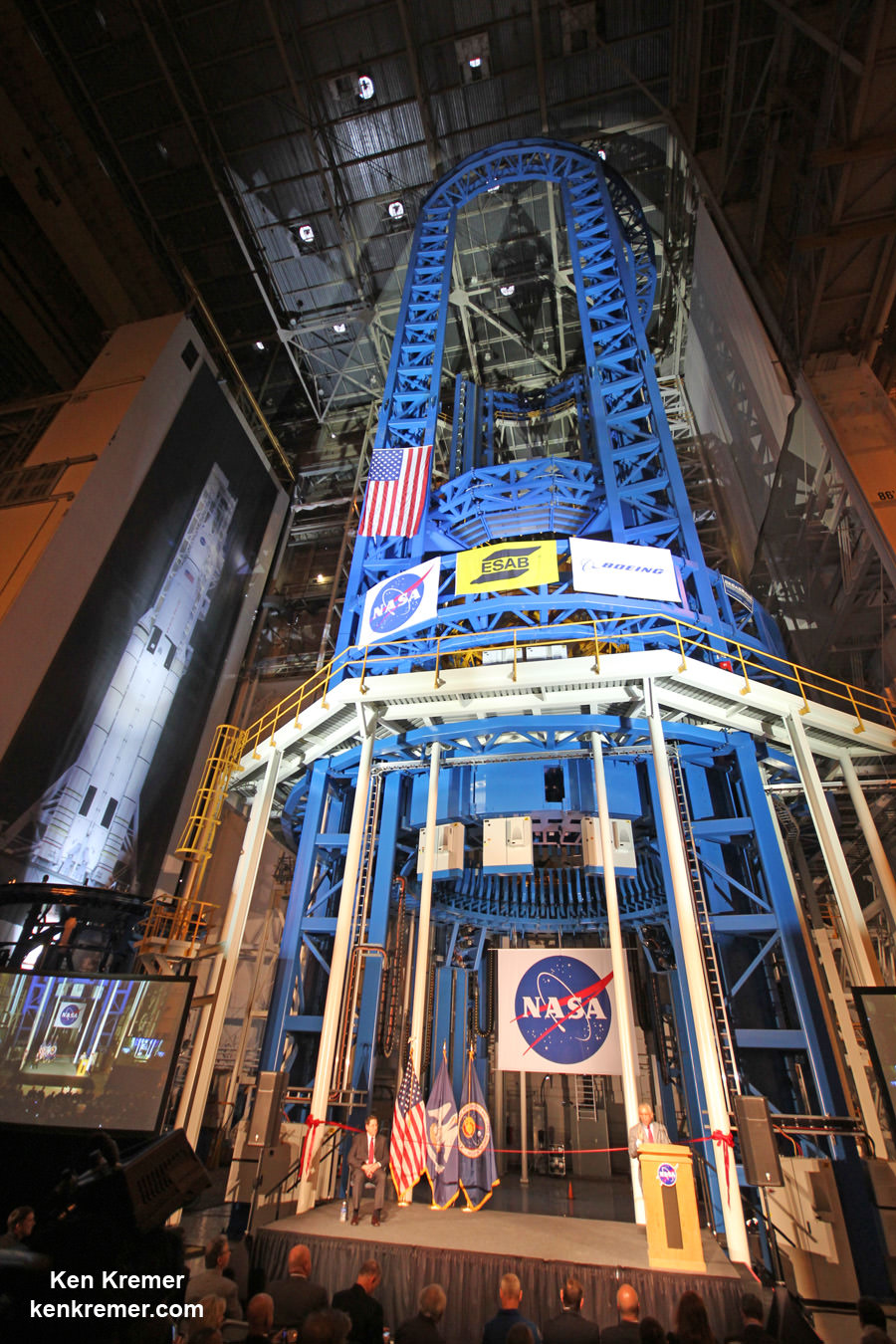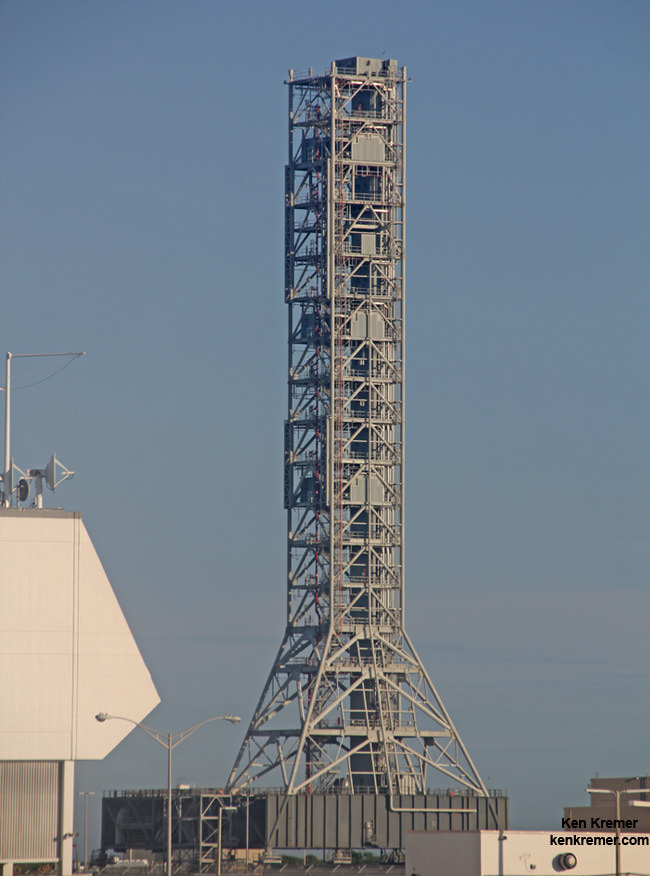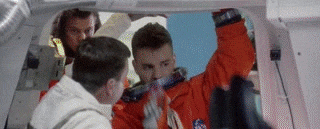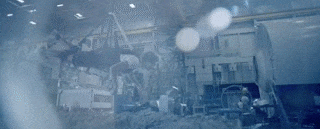Welcome, come in to the 497th Carnival of Space! The Carnival is a community of space science and astronomy writers and bloggers, who submit their best work each week for your benefit. I’m Susie Murph, part of the team at Universe Today and CosmoQuest. So now, on to this week’s stories!
Continue reading “Carnival of Space #497”
Weekly Space Hangout – November 11, 2016: Pat Ammons of Space Camp, and Bob King of “Night Sky With The Naked Eye”
Host: Fraser Cain (@fcain)
Special Guests:
Pat Ammons is Director of Communications, U.S. Space & Rocket Center, to discuss SpaceCamp.
Bob King is a UT contributor who will be joining us to promote his new book “Night Sky with the Naked Eye.”
Guests:
Kimberly Cartier ( KimberlyCartier.org / @AstroKimCartier )
Morgan Rehnberg (MorganRehnberg.com / @MorganRehnberg)
Their stories this week:
What will Trump’s space policy look like?
Is NASA preparing to abandon Orion?
An exotic pair of stellar remnants
Subaru’s new exoplanet atmosphere instrument
We use a tool called Trello to submit and vote on stories we would like to see covered each week, and then Fraser will be selecting the stories from there. Here is the link to the Trello WSH page (http://bit.ly/WSHVote), which you can see without logging in. If you’d like to vote, just create a login and help us decide what to cover!
If you would like to join the Weekly Space Hangout Crew, visit their site here and sign up. They’re a great team who can help you join our online discussions!
If you would like to sign up for the AstronomyCast Solar Eclipse Escape, where you can meet Fraser and Pamela, plus WSH Crew and other fans, visit our site linked above and sign up!
We record the Weekly Space Hangout every Friday at 12:00 pm Pacific / 3:00 pm Eastern. You can watch us live on Universe Today, or the Universe Today YouTube page.
Space Station Back At Dusk / See Orion’s Curlicue and Five Dawn Planets
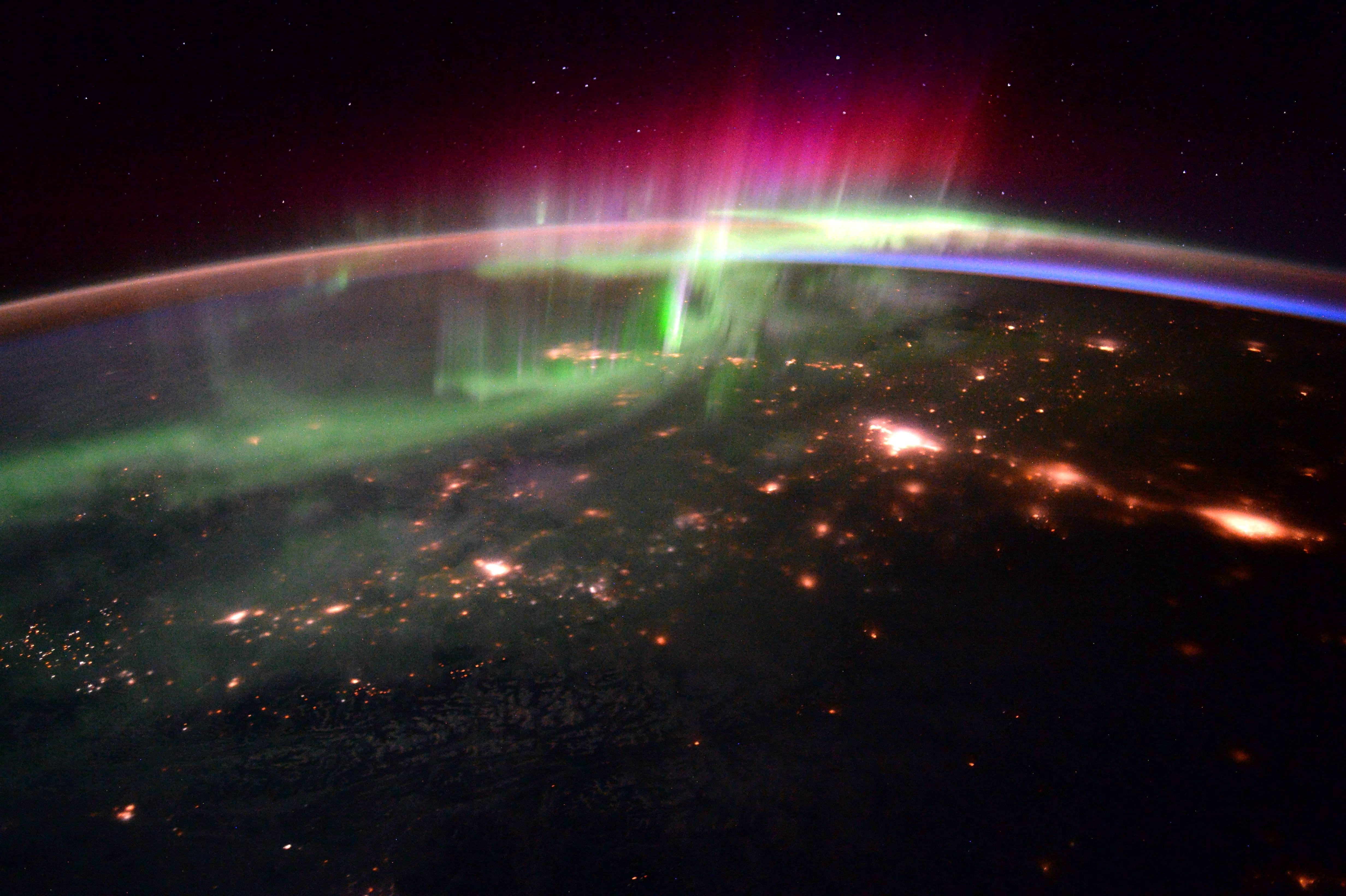
I hadn’t been paying attention, so I was pleasantly surprised two nights ago to see the International Space Station (ISS) made a bright pass in the southwestern sky. A quick check revealed that another round of evening passes had begun for locations across the central and northern U.S., Canada and Europe. I like the evening ones because they’re so much convenient to view than those that occur at dawn. You can find out when the space station passes over your house at NASA’s Spot the Station site or Heavens Above.
The six-member Expedition 46 crew are wrapping up their work week on different types of research including botany, bone loss and pilot testing. Plants are being grown on the International Space Station so future crews can learn to become self-sustainable as they go farther out in space. While they work their jobs speeding at more than 17,000 mph overhead, we carry on here on the surface of the blue planet.
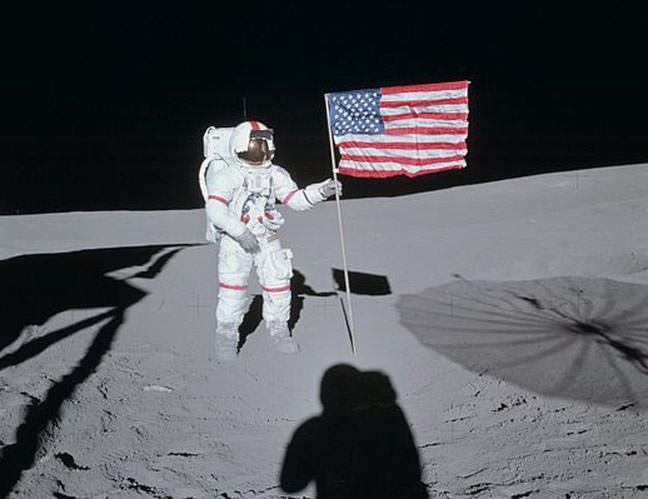
U.S. astronaut Scott Kelly regularly tweets photos from the station and recently noted the passing of Apollo 14 astronaut Edgar Mitchell, who died Thursday at age 85 on the eve of the 45th anniversary of his lunar landing on February 5, 1971. Mitchell was one of only 12 people to walk on the moon and described the experience to the UK Telegraph in 2014:
Relive the Mitchell’s Apollo 14 mission to the moon in 9 minutes and 57 seconds
“Looking at Earth from space and seeing it was a planet in isolation … that was an experience of ecstasy, realizing that every molecule in our bodies is a system of matter created from a star hanging in space. The experience I had was called Samadhi in the ancient Sanskrit, a feeling of overwhelming joy at seeing the Earth from that perspective.”
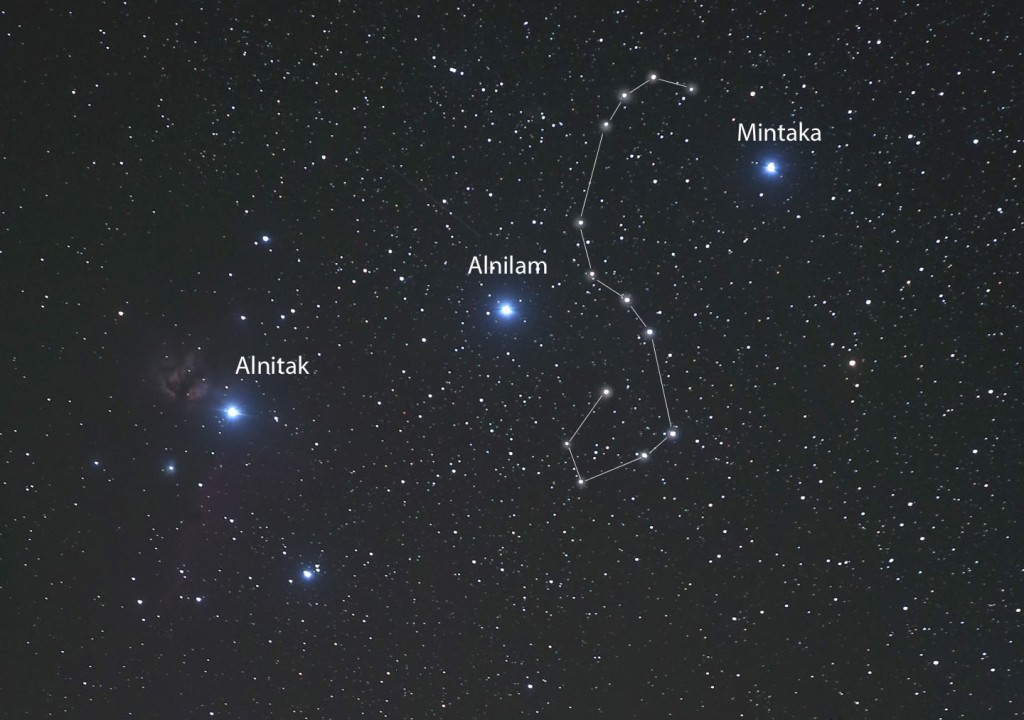
Only a human could stand in so barren and forbidding a place and experience such profound joy. You don’t have to go to the moon to be moved by sights in the night. Just step outside and watch the ISS glide by or grab a pair of binoculars and aim them at Orion’s Belt. Orion stands due south around 8 o’clock in in mid-February practically shouting to be looked at.
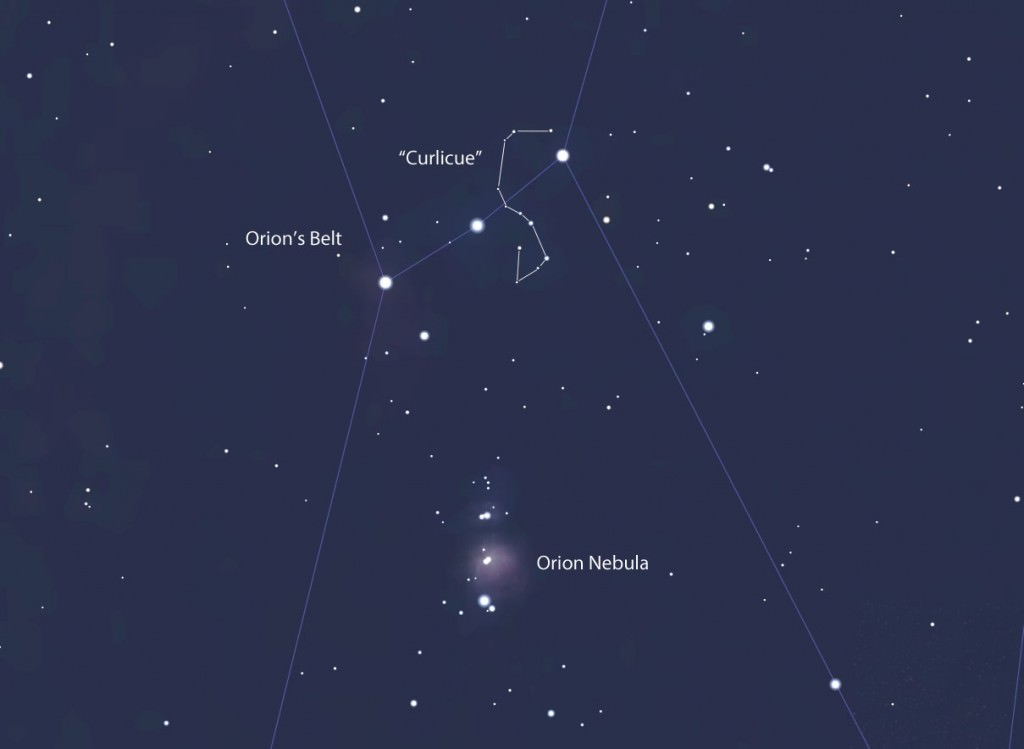
The Belt is lovely enough, but its surroundings glitter with stars just below the naked eye limit, in particular a little curlicue or “S” between Alnilam and Mintaka composed of 6th and 7th magnitude stars. Look for it in any pair of binoculars and don’t stop there. Take a few minutes to sweep the area and enjoy the starry goodness about then drop a field of view south for a look at the Orion Nebula. Inside this fuzzy spot 10 light years across and 1,350 light years away, hundreds of new stars are incubating, waiting for the day they can blaze forth like their compadres that make up the rest of Orion.
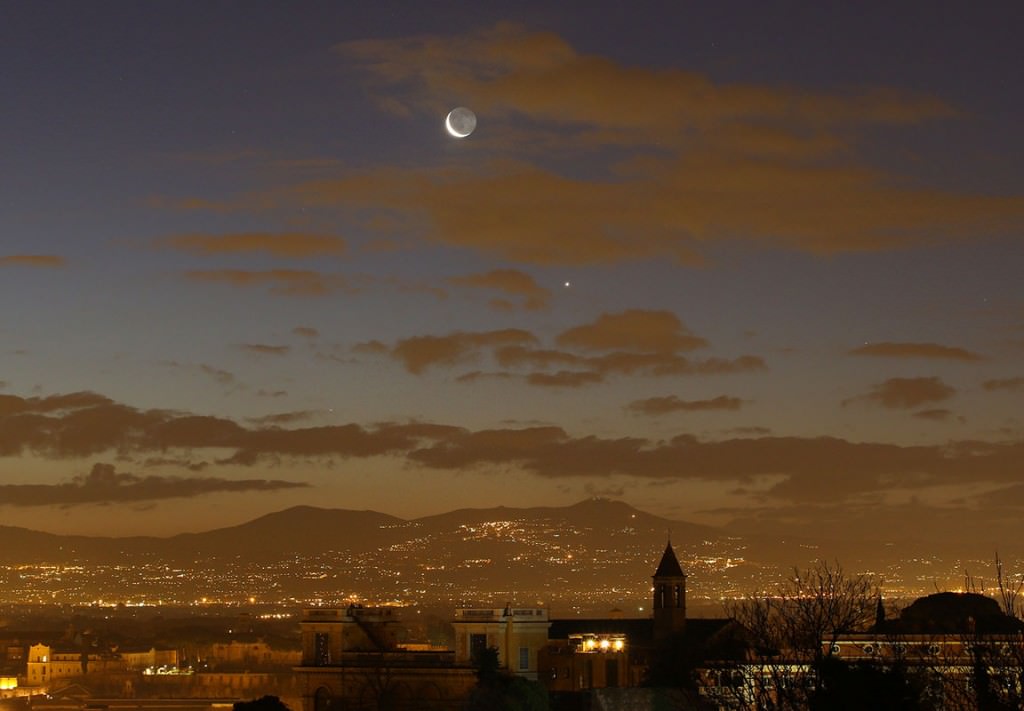
After touting the advantages of evening sky watching, forgive me if I also direct you to the morning sky and potential sleep loss. Although the waning crescent moon has now departed the scene, the wonderful alignment of Mercury, Venus, Saturn, Mars and Jupiter remains visible in the coming week even as Mercury slowly sinks back toward the eastern horizon. If you haven’t seen this “gang of 5”, set your alarm for a look starting about an hour before sunrise.
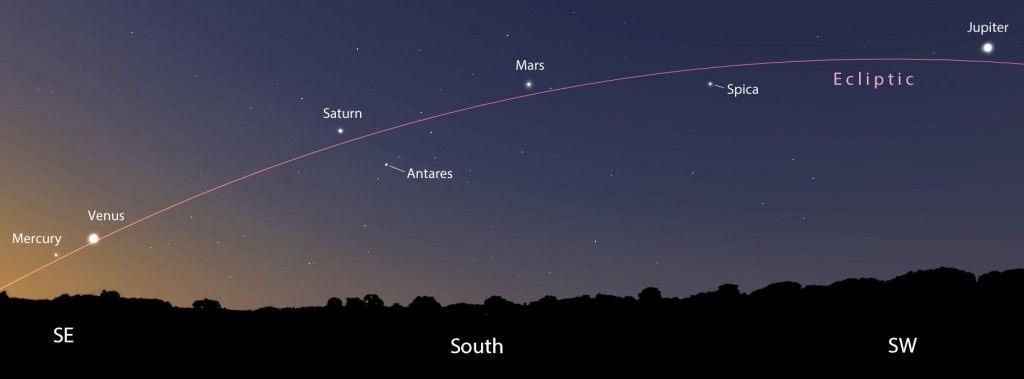
Find a location with as wide open a view as possible of the southeastern horizon. Jupiter, Mars and Saturn are plenty high up at that time and easy to spot, but Venus and Mercury hover only 5°-10° high. Both will pose no problem if you can get the trees and buildings out of the way! By the end of the coming week, Mercury will become challenging and then slip away.
Clear skies!
NASA’s Orion Crew Module Backbone Arrives at KSC Aboard Super Guppy for Exploration Mission-1
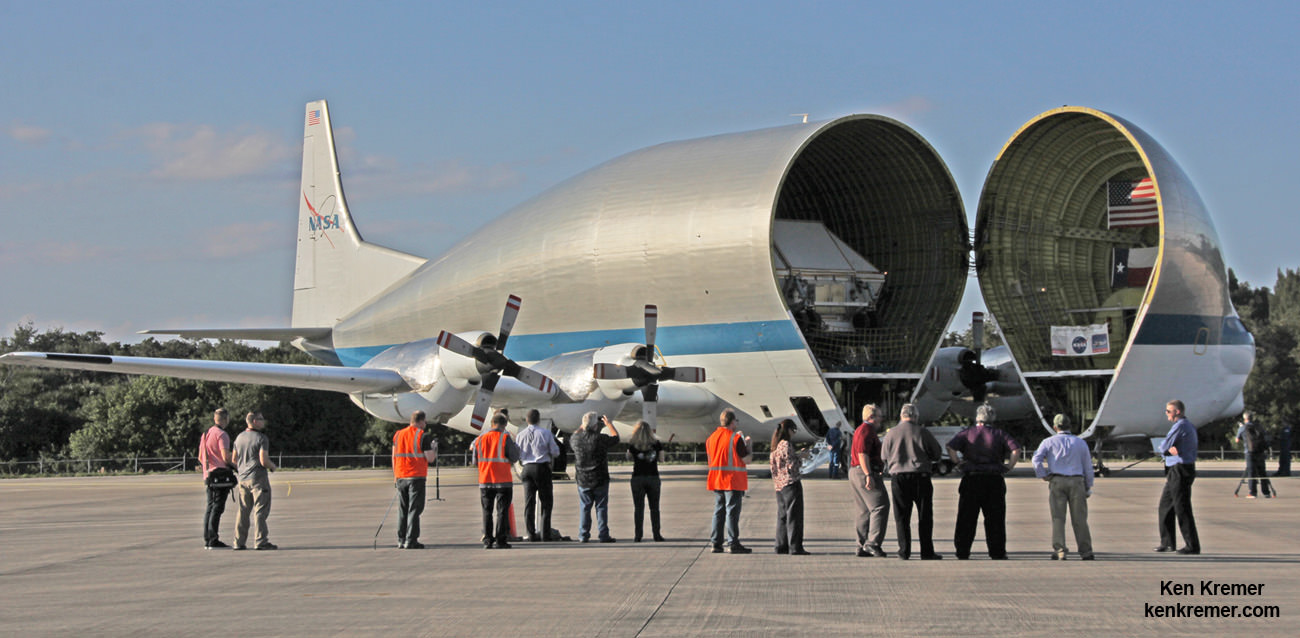

KENNEDY SPACE CENTER – Looking amazingly like a fish flying across the skies high above the Florida space coast, NASA’s unique Super Guppy aircraft loaded with the structural backbone for NASA’s next Orion crew module, swooped in for a landing at the Kennedy Space Center on Monday afternoon, Feb. 1.
The Super Guppy, with the recently completed pressure vessel for the Orion crew module tucked safely inside, touched down gently at about 3:45 p.m. Monday on the same runway at the Shuttle Landing Facility (SLF) where NASA’s now retired orbiters formerly returned from space voyages. The landing strip is now operated by Space Florida. Continue reading “NASA’s Orion Crew Module Backbone Arrives at KSC Aboard Super Guppy for Exploration Mission-1”
Orion Gets Beefed Up, Silver-Metallic Thermal Protection Coating for Next Flight on EM-1
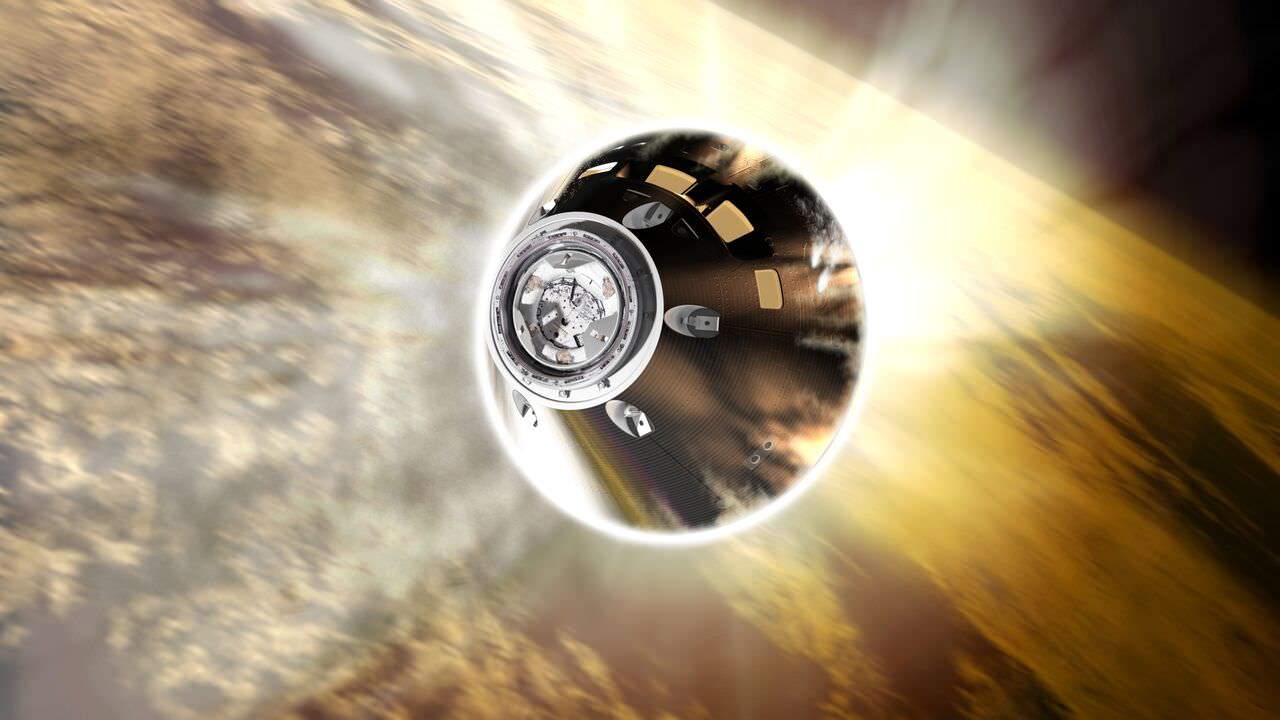

In the wake of NASA’s supremely successful inaugural test flight of the Orion deep space capsule on the EFT-1 mission in Dec. 2014, NASA is beefing up the critical thermal protection system (TPS) that will protect astronauts from the searing heats experienced during reentry as the human rated vehicle plunges through the Earth’s atmosphere after returning from ambitious expeditions to the Moon and beyond.
Based in part on lessons learned from EFT-1, engineers are refining Orion’s heat shield to enhance the design, ease manufacturing procedures and significantly strengthen is heat resistant capabilities for the far more challenging space environments and missions that lie ahead later this decade and planned further out in the future as part of NASA’s agency-wide ‘Journey to Mars’ initiative to send humans to the Red Planet in the 2030s.
On all future flights starting with Exploration Mission 1 (EM-1), the Orion crew module must Continue reading “Orion Gets Beefed Up, Silver-Metallic Thermal Protection Coating for Next Flight on EM-1”
Tonight’s the Night! Maps to Help You Spot Asteroid TB145
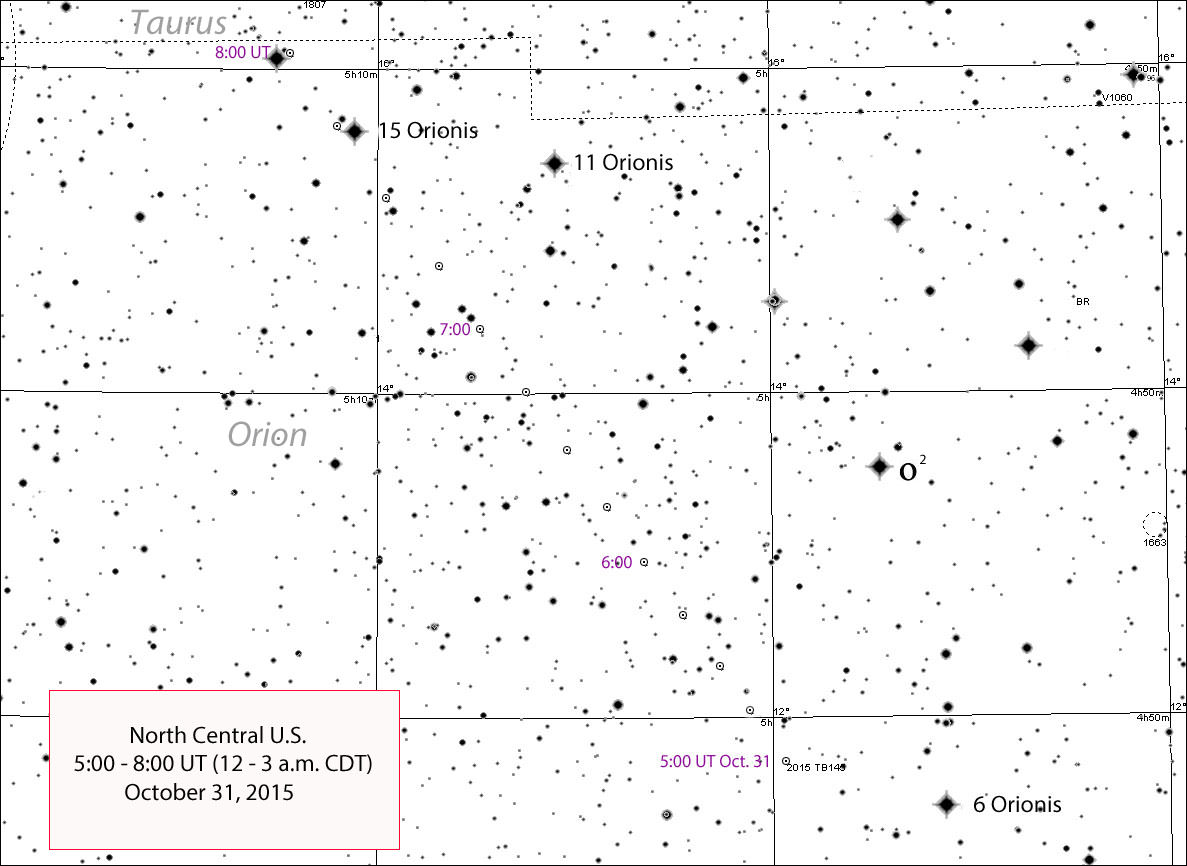
This simulation by Tom Ruen shows the trajectory of 2015 TB145 across the sky, showing tracer spheres spaced at one hour intervals along its path.
Halloween fireballs, a Supermoon and now a near-Earth asteroid flyby. What a week! While 2015 TB145 won’t be visible in binoculars because of its relative faintness and glare from a nearby waning gibbous Moon, you should be able to see it in an 8-inch telescope or larger telescope without too much difficulty.
Determined amateurs might even catch it in instruments as small as 4.5 inches especially tomorrow morning when the fleeing space mountain will brighten to around magnitude +10.
For western hemisphere observers, TB145 begins the evening in Orion’s Shield not far below the Hyades Cluster looking like a magnitude +11.5 star crawling northeast through the star field. By dawn on Halloween, it will top out around magnitude +10.2 as it zips through Taurus and Auriga traveling around 3-5° per hour depending on the time you look. For most of the night, TB145 will move swiftly enough to notice its motion in real time, resembling an Earth-orbiting satellite. Closest approach occurs around 17:00 UT (noon CDT) when it pass along bottom of the Big Dipper Bowl at around 10° hour. Amazing!
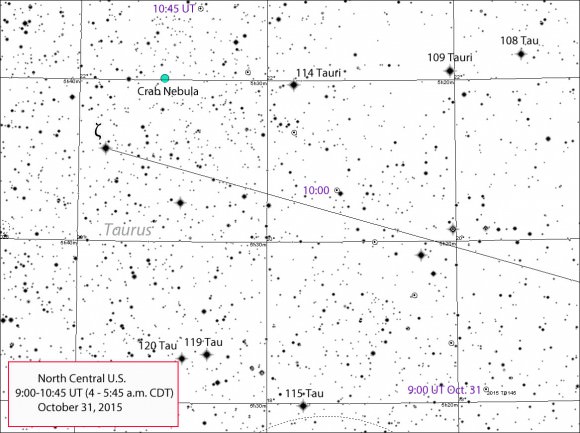
My hope is that these maps will help you spot and follow this zippy, aircraft carrier-sized boulder. Three of the four maps cover most of the time between 5:00 and 11:45 UT, equivalent to midnight CDT tonight to 6:45 a.m. tomorrow morning. I used the very latest orbital elements and hand plotted the positions (a tedious exercise but worth it!) at 15-minute intervals. For convenience, when you print them out, I’d suggest using a straight edge to draw a line connecting the position dots.
As we discussed in the previous Universe Today story, parallax comes into play when viewing any nearby Solar System object. Three of the maps show the asteroid’s position from the North Central U.S. One depicts the view from the South Central U.S. from 11-11:45 UT. Parallax is minor early on from midnight to 2 or 3 a.m. but becomes more significant near closest approach. This is based on comparisons I made between latitudes 47°-32° North.
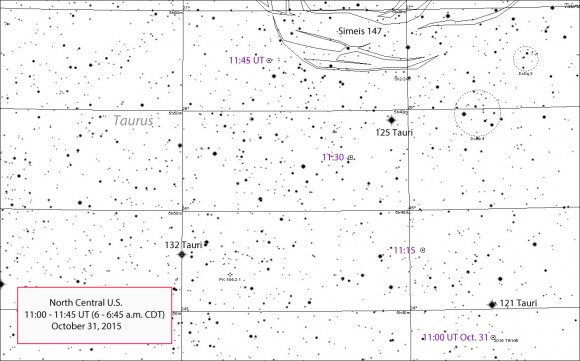
I apologize for the limited number of maps in this article but hope these and the do-it-yourself approach described in the earlier article will be enough to set you on TB145’s trail.
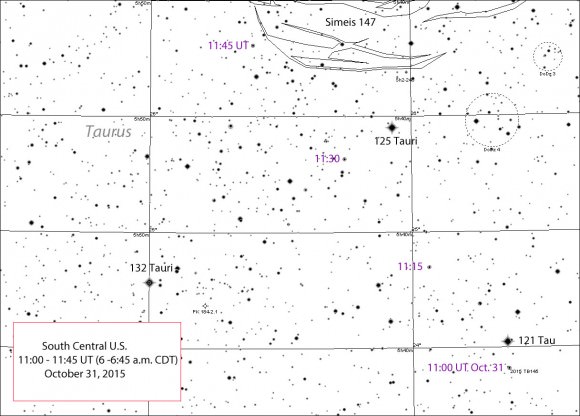
As always when trying to spot asteroids on the move, pick a time and camp out at that spot with your telescope five minutes before the expected arrival time. Take the time to casually memorize the star patterns, so when the interloper arrives, you’ll pick it out straightaway. Again, depending on your location both east-west and north-south of the paths charted, TB145 may arrive a couple minutes earlier or later, but once you spot it, hold on tight. You’ll be going on a most exciting ride!
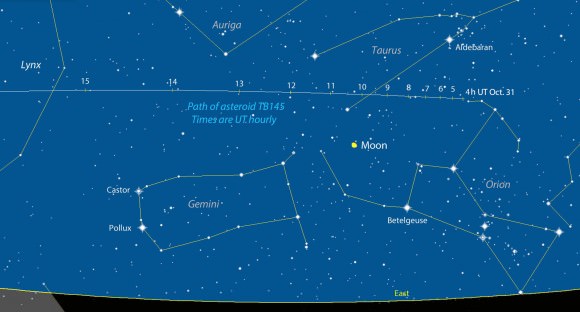
We’d love to hear from you whether or not you were successful seeing it. If the weather’s uncooperative or you don’t have a telescope, Gianluca Masi’s got your back. He’ll webcast the flyby live on his Virtual Telescope site starting at 7 p.m. CDT (0:00 UT) tonight Oct. 30-31.
Now let’s see the flyby of Earth from the asteroid’s point of view, also by Tom Ruen. Enjoy!
Mobile Launcher Upgraded to Launch NASA’s Mammoth ‘Journey to Mars’ Rocket
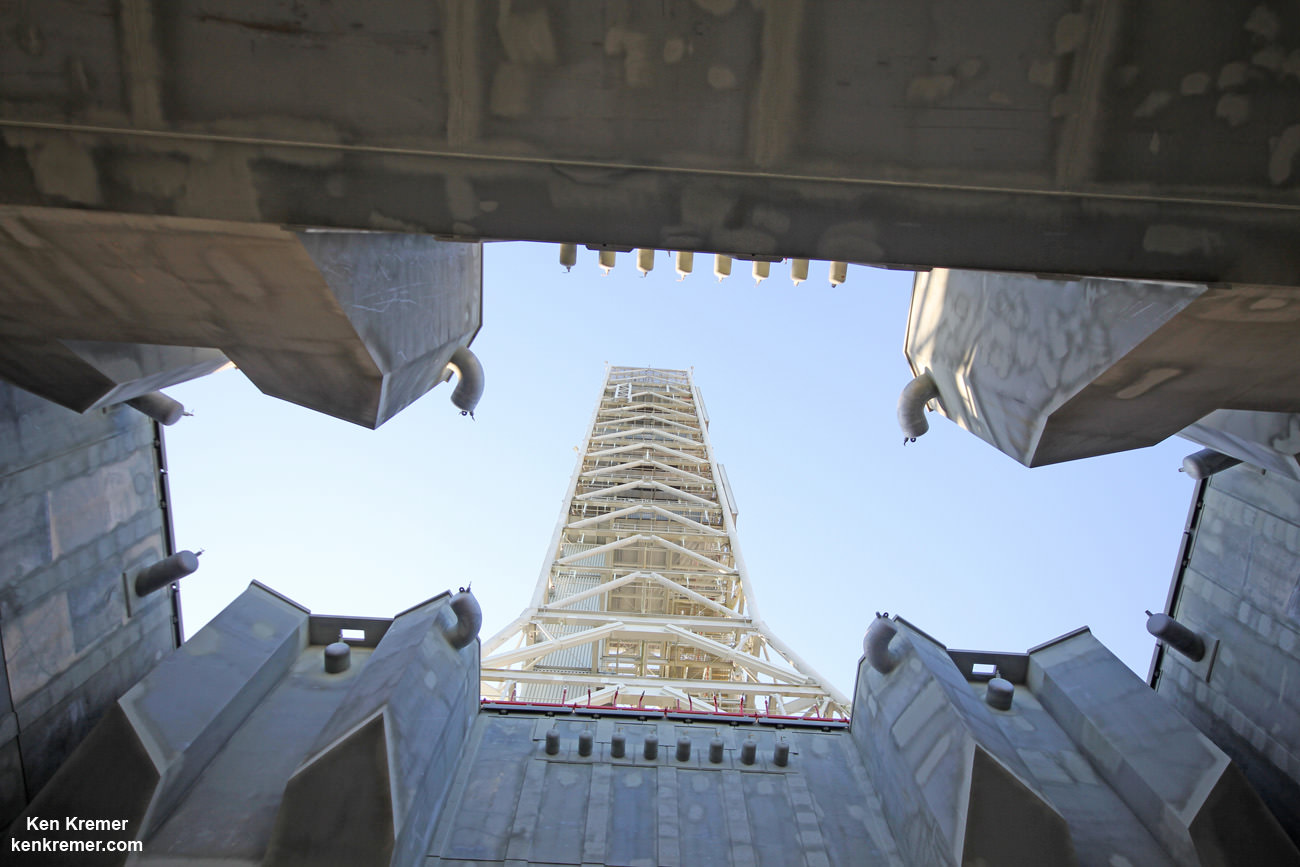
Looking up from beneath the enlarged exhaust hole of the Mobile Launcher to the 380 foot-tall tower astronauts will ascend as their gateway for missions to the Moon, Asteroids and Mars. The ML will support NASA’s Space Launch System (SLS) and Orion spacecraft during Exploration Mission-1 at NASA’s Kennedy Space Center in Florida. Credit: Ken Kremer/kenkremer.com
Story/photos updated[/caption]
KENNEDY SPACE CENTER, FL – NASA’s Mobile Launcher (ML) is undergoing major upgrades and modifications at the Kennedy Space Center in Florida enabling the massive structure to launch the agency’s mammoth Space Launch System (SLS) rocket and Orion crew capsule on a grand ‘Journey to Mars.’
“We just finished up major structural steel modifications to the ML, including work to increase the size of the rocket exhaust hole,” Eric Ernst, NASA Mobile Launch project manager, told Universe Today during an exclusive interview and inspection tour up and down the Mobile Launcher.
Indeed the Mobile Launcher is the astronauts gateway to deep space expeditions and missions to Mars.
Construction workers are hard at work upgrading and transforming the 380-foot-tall, 10.5-million-pound steel structure into the launcher for SLS and Orion – currently slated for a maiden blastoff no later than November 2018 on Exploration Mission-1 (EM-1).
“And now we have just started the next big effort to get ready for SLS.”
SLS and Orion are NASA’s next generation human spaceflight vehicles currently under development and aimed at propelling astronauts to deep space destinations, including the Moon and an asteroid in the 2020s and eventually a ‘Journey to Mars’ in the 2030s.
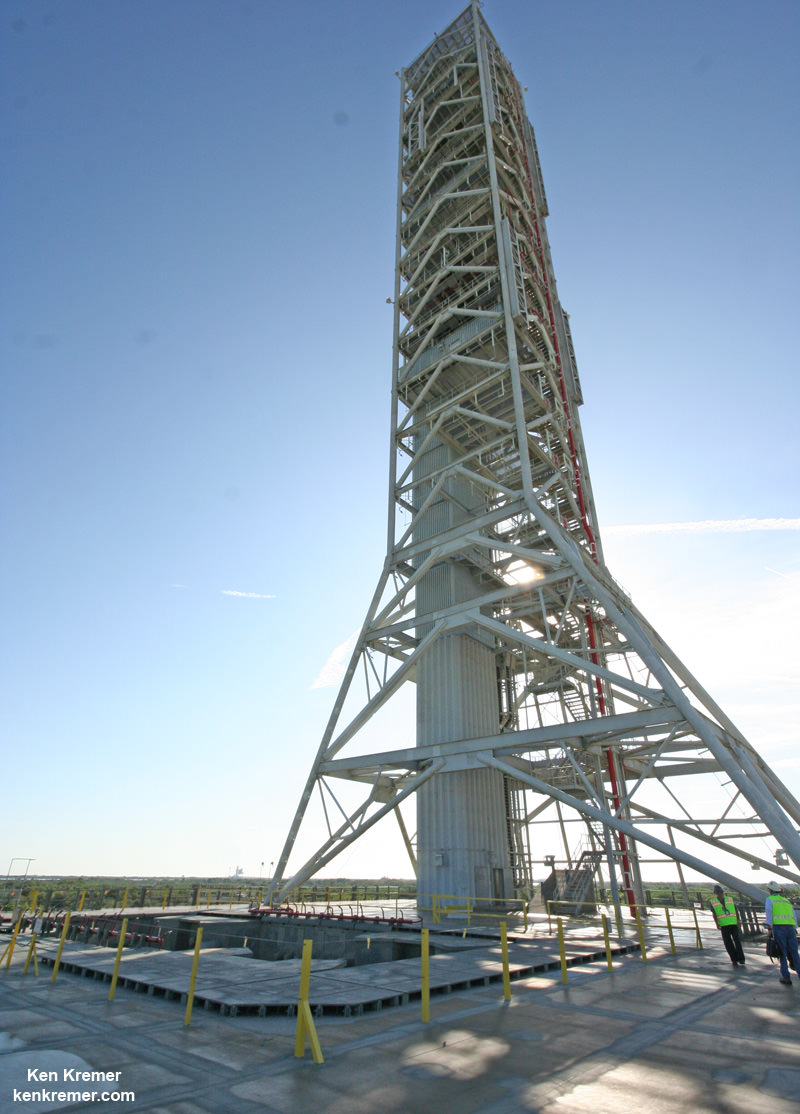
The mobile launcher was originally built several years ago to accommodate NASA’s less powerful, lighter and now cancelled Ares-1 rocket. It therefore requires extensive alterations to accommodate the vastly more powerful and heavier SLS rocket.
“The ML was initially developed for Ares 1, a much smaller rocket,” Ernst explained to Universe Today.
“So the exhaust hole was much smaller.”
Whereas the Ares-1 first stage booster was based on using a single, more powerful version of the Space Shuttle Solid Rocket Boosters, the SLS first stage is gargantuan and will be the most powerful rocket the world has ever seen.
The SLS first stage comprises two shuttle derived solid rocket boosters and four RS-25 power plants recycled from their earlier life as space shuttle main engines (SSMEs). They generate a combined 8.4 million pounds of thrust – exceeding that of NASA’s Apollo Saturn V moon landing rocket.
Therefore the original ML exhaust hole had to be gutted and nearly tripled in width.
“The exhaust hole used to be about 22 x 22 feet,” Ernst stated.
“Since the exhaust hole was much smaller, we had to deconstruct part of the tower at the base, in place. The exhaust hole had to be made much bigger to accommodate the SLS.”
Construction crews extensively reworked the exhaust hole and made it far wider to accommodate SLS compared to the smaller one engineered and already built for the much narrower Ares-1, which was planned to generate some 3.6 million pounds of thrust.
“So we had to rip out a lot of steel,” Mike Canicatti, ML Construction Manager told Universe Today.
“For the exhaust hole [at the base of the tower], lots of pieces of [existing] steel were taken out and other new pieces were added, using entirely new steel.”
“The compartment for the exhaust hole used to be about 22 x 22 feet, now it’s about 34 x 64 feet.”
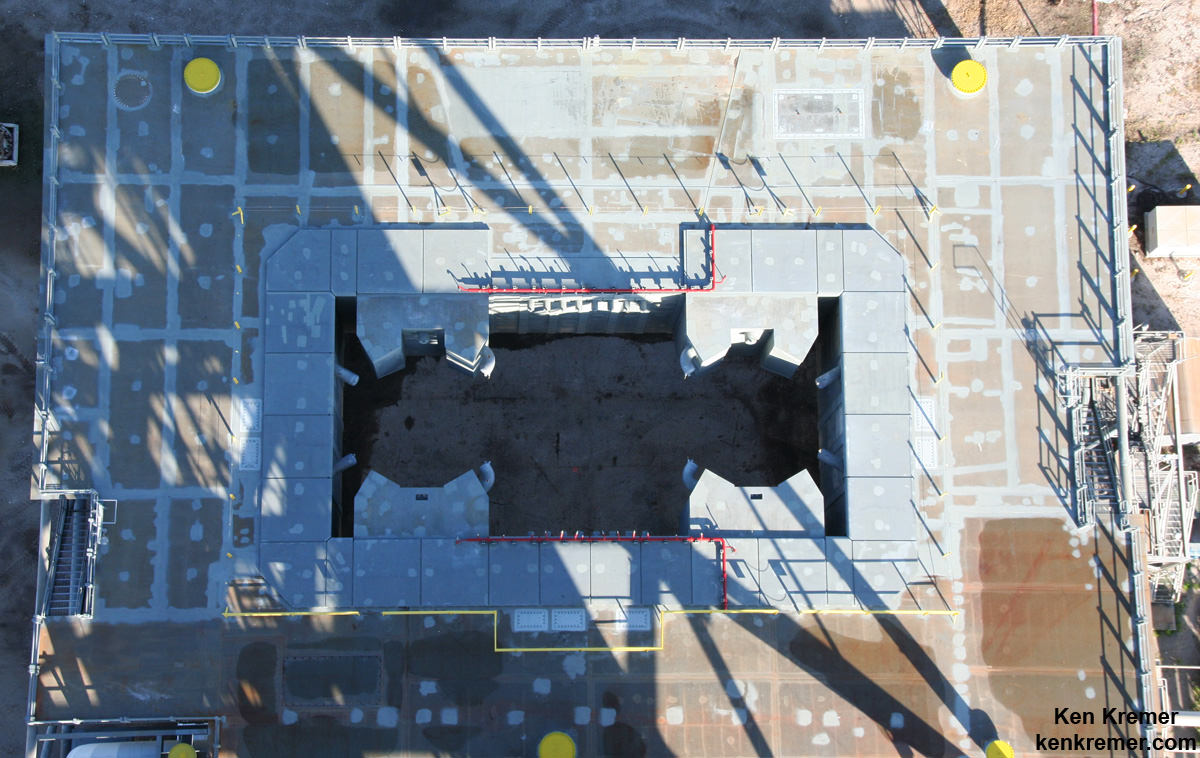
In fact this involved the demolition of over 750 tons of old steel following by fabrication and installation of more than 1,000 tons of new steel. It was also reinforced due to the much heavier weight of SLS.
“It was a huge effort and structural engineers did their job. The base was disassembled and reassembled in place” – to enlarge the exhaust hole.
“So basically we gutted major portions of the base out, put in new walls and big structural girders,” Ernst elaborated.
“And we just finished up that major structural steel modification on the exhaust hole.”
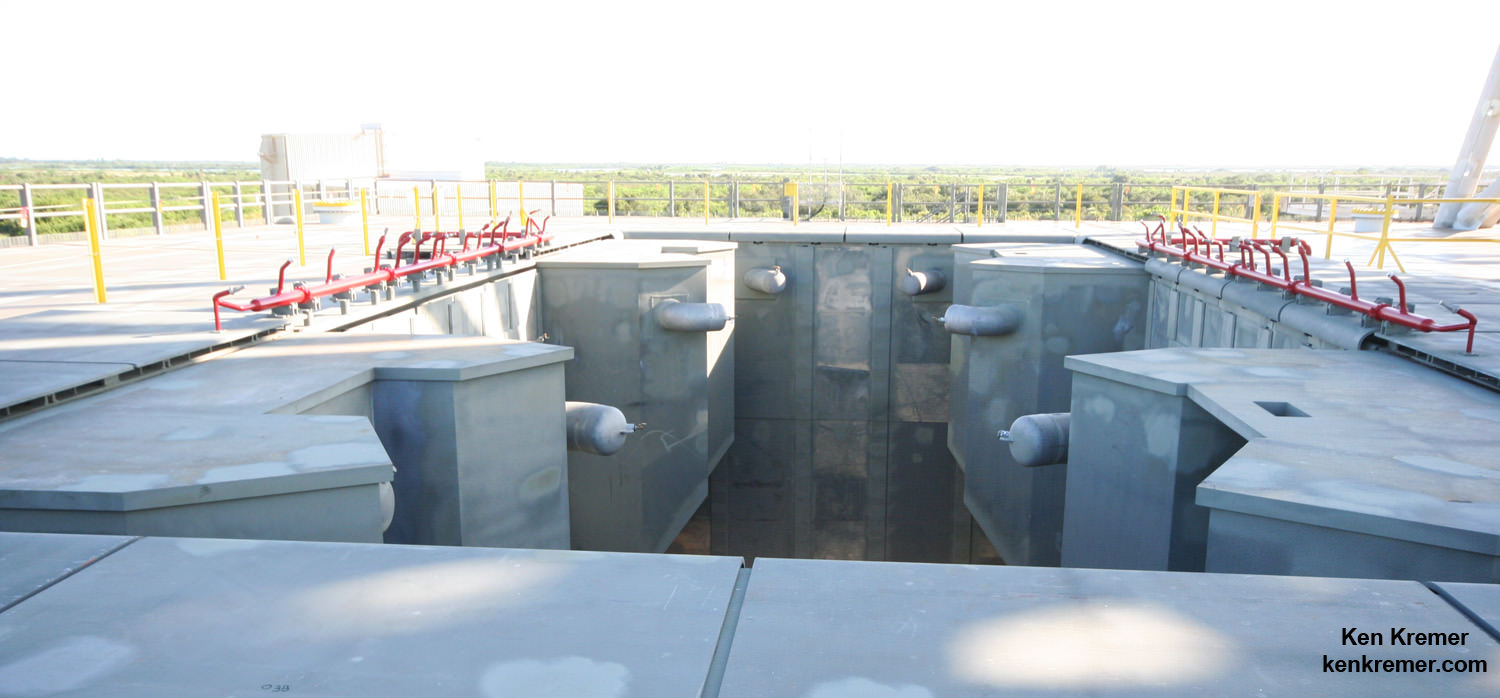
Meanwhile the 380 foot-tall tower that future Orion astronauts will ascend was left in place.
“The tower portion itself did not need to be disassembled.”
The Ares rockets originally belonged to NASA’s Constellation program, whose intended goal was returning American astronauts to the surface of the Moon by 2020.
Ares-1 was slated as the booster for the Orion crew capsule. However, President Obama cancelled Constellation and NASA’s Return to the Moon soon after entering office.
Since then the Obama Administration and Congress worked together in a bipartisan manner together to fashion a new space hardware architecture and granted approval for development of the SLS heavy lift rocket to replace the Ares-1 and heavy lift Ares-5.
Sending astronauts on a ‘Journey to Mars’ is now NASA’s agency wide and overarching goal for the next few decades of human spaceflight.
But before SLS can be transported to its launch pad at Kennedy’s Space Launch Complex 39-B for the EM-1 test flight the next big construction step has to begin.
“So now we have just started the next big effort to get ready for SLS.”
This involves installation of Ground Support Equipment (GSE) and a wide range of launch support services and systems to the ML.
“The next big effort is the GSE installation contract,” Ernst told me.
“We have about 40+ ground support and facility systems to be installed on the ML. There are about 800 items to be installed, including about 300,000-plus feet of cable and several miles of piping and tubing.”
“So that’s the next big effort to get ready for SLS. It’s about a 1.5 year contract and it was just awarded to J.P. Donovan Construction Inc. of Rockledge, Florida.”
“The work just started at the end of August.”
NASA currently plans to roll the ML into the Vehicle Assembly Building in early 2017 for stacking of SLS and Orion for the EM-1 test flight.
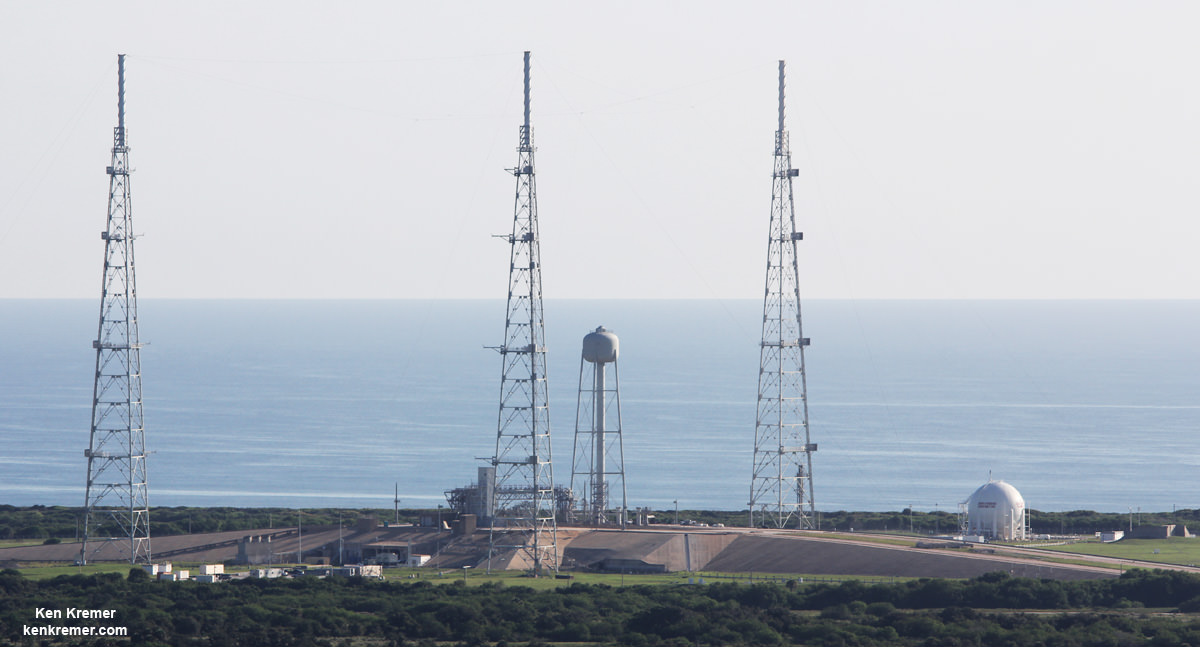
The SLS/Orion mounted stack atop the ML will then roll out to Space Launch Complex 39B for the 2018 launch from the Kennedy Space Center.
Pad 39B is also undergoing radical renovations and upgrades, transforming it from its use for NASA’s now retired Space Shuttle program into a modernized 21st century launch pad. Watch for my upcoming story.
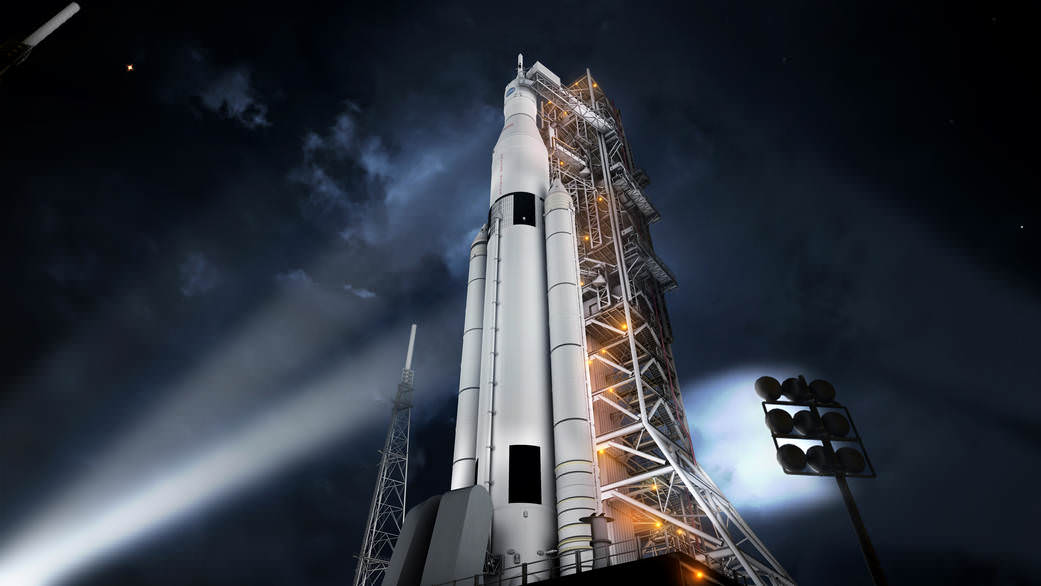
Stay tuned here for Ken’s continuing Earth and planetary science and human spaceflight news.
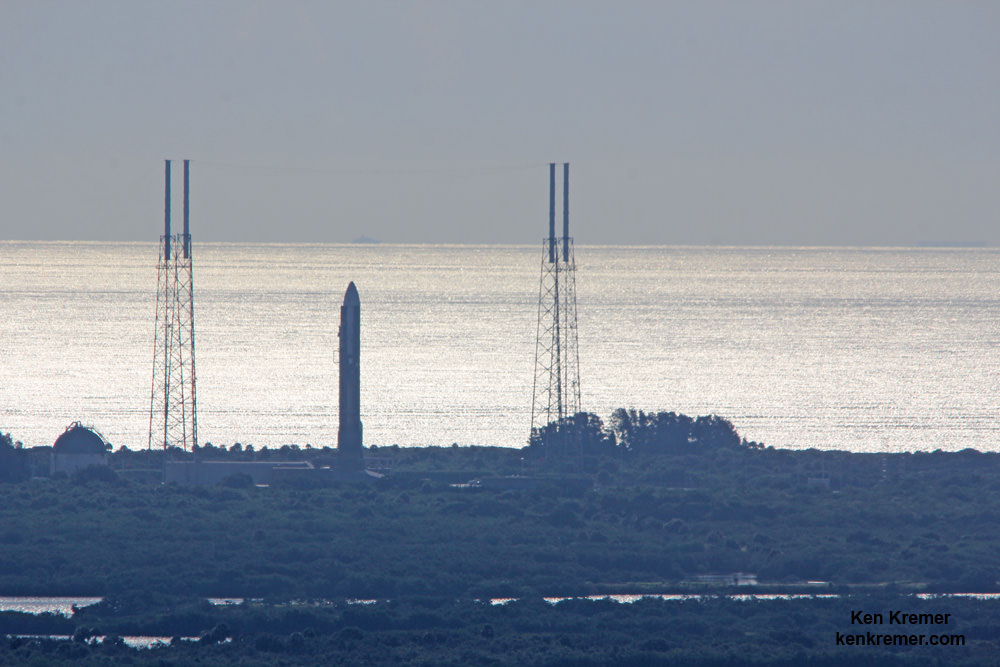
Weekly Space Hangout – Sept 18, 2015: Planet Hunter Prof. Sara Seager
Host: Fraser Cain (@fcain)
Special Guests:
Dr. Sara Seager, whose research focuses on computer models of exoplanet atmospheres, interiors, and biosignatures. Her favorite projects involve the search for planets like Earth with signs of life
on them.
Guests:
Paul Sutter (pmsutter.com / @PaulMattSutter)
Morgan Rehnberg (cosmicchatter.org / @MorganRehnberg )
Pamela Gay (cosmoquest.org / @cosmoquestx / @starstryder)
Continue reading “Weekly Space Hangout – Sept 18, 2015: Planet Hunter Prof. Sara Seager”
‘One Direction’ Heads to Space in new NASA Themed Music Video – ‘Drag Me Down’
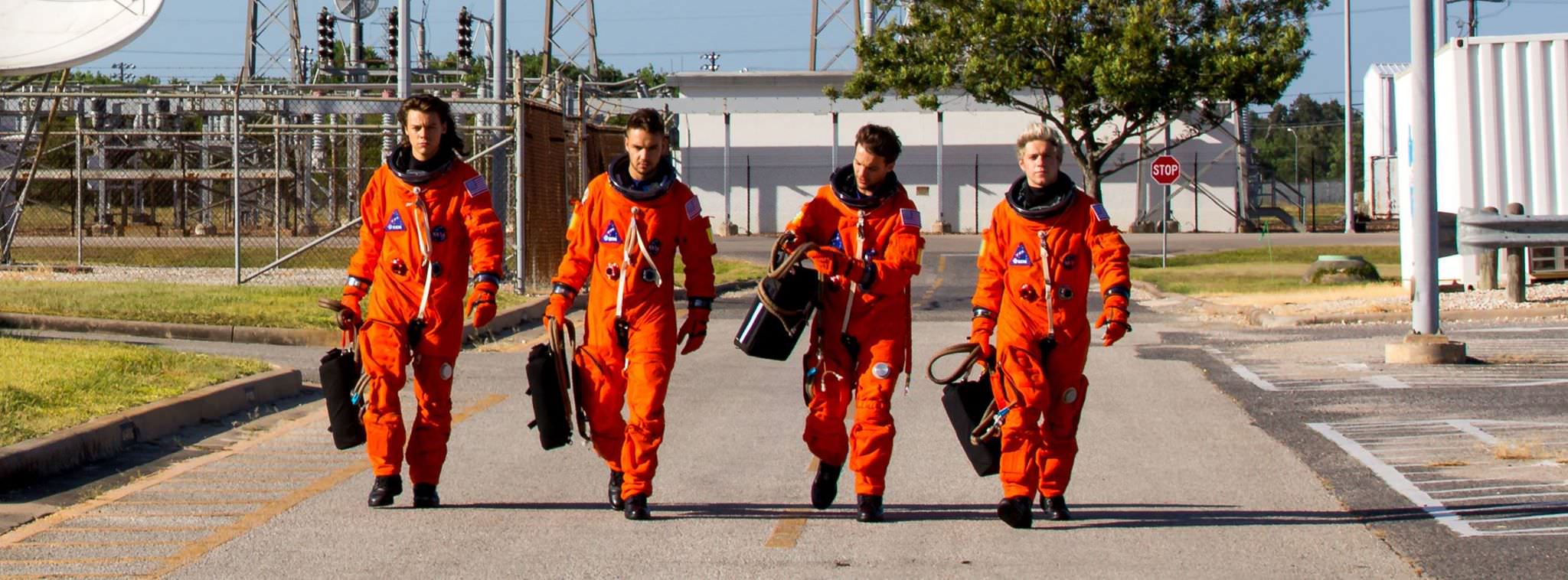
When it comes to space exploration it’s resoundingly clear that rock band ‘One Direction’ is headed in the right direction – To Infinity and Beyond! – with the release of their new NASA themed music video ‘Drag Me Down.’
The new single – ‘Drag Me Down’ – by the world famous boy band is out now and out of this world!
Just click on the Vevo video above and enjoy their musical tour through space exploration themed videos filmed on location at NASA facilities, including the Johnson Space Center – home to astronauts training to explore ‘Where No One Has Gone Before.’
Over 18,100,000 views so far!! Millions of eyeballs exposed to NASA activities like never before!
As you’ll see in the video (published on Aug. 20) the quartet got a first hand look at a host of NASA’s cutting edge technology and hardware like NASA’s Orion deep space crew capsule that’s destined to propel our astronauts back to deep space and explore wondrous destinations including the Moon, asteroids and the Red Planet, as part of the agency’s ‘Journey to Mars’ initiative.
Motivating our young people to study and excel in math, science, engineering, technology and the arts is what it’s all about to inspire the next generation of explorers and advance all humanity to fulfilling and prosperous lives.
“#DragMeDownMusicVideo @space_station Gravity can’t drag me down! Great to see @NASA inspire our next gen #YearInSpace,” tweeted NASA astronaut Scott Kelly currently working aboard the International Space Station.
Lets join “One Direction’s” space tour.
So the guys donned NASA’s spacesuits as they began ‘training’ to fly aboard NASA’s Orion spaceship.

Orion flew its first uncrewed mission on the EFT-1 flight in December 2014, launching aboard a United Launch Alliance Delta IV Heavy rocket.
Harry, Niall, Louis and Liam all got suited up to check out and sit inside an Orion trainer. Next you’ll see them ‘blast off’ for space atop the Delta IV rocket from the Florida Space Coast in their music video.
But first they rollick with the astronauts T-38 training jets which are used by real-life astronauts to practice spacecraft operations at supersonic speeds up to Mach 1.6 and experience blistering accelerations of more than seven Gs!
Here we join Louis to rove around Johnson Space Center in NASA’s Space Exploration Vehicle that will one day be used for awe-inspiring interplanetary journey’s to the surface of alien bodies like the moon, near-Earth asteroids and Mars!
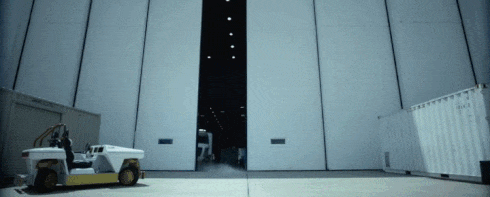
Wouldn’t you like to join Louis!
Meanwhile Harry got to hang out with Robonaut at the Johnson Space Center during the filming of the music video.
Simultaneously the Robonauts twin brother, Robonaut 2, is hanging out in space right now with other humans. Robonaut 2 is working side-by-side with NASA astronauts Scott Kelly and Kjell Lindgren and the rest of the six man crew floating aboard the International Space Station and soaring some 250 miles (400 kilometers) overhead.
“Going where the risks are too great for people, robots will make it so we never get ‘dragged down’!” says NASA.
“Currently living in space, @StationCDRKelly is 1 of 6 people that literally cannot be dragged down. #DragMeDown,” NASA tweeted.
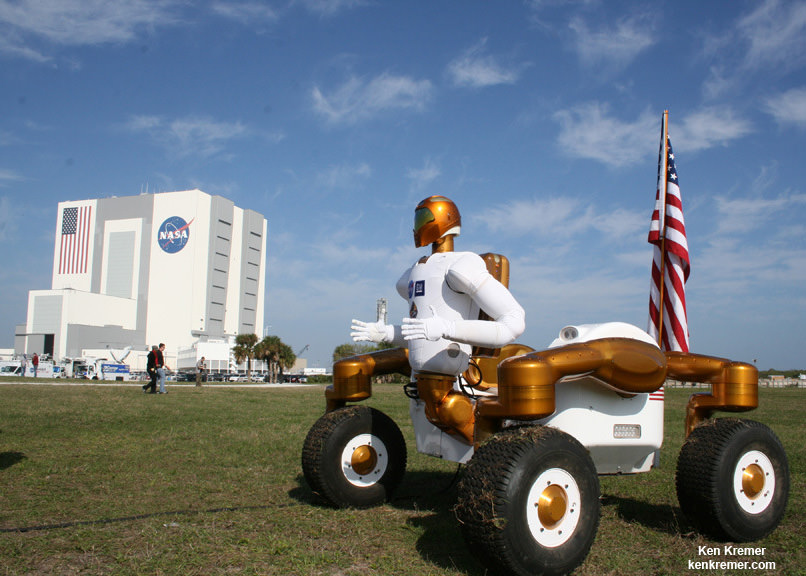
And here’s Niall experiencing reduced gravity in the Partial Gravity Simulator & Space Station Mockup Bike. This simulator is where astronauts learn how to work effectively in the partial gravity of space and on the surface of other worlds
I’ve been a fan of ‘One Direction’ and now nothing will ‘hold me back’ following #DragMeDown.
And don’t forget that you can watch Commander Scott Kelly and his five international crew mates on a regular basis as they soar overhead. Just click on NASA’s Spot the Station link and plug in your location.
And make sure you sign up to ‘Send Your Name to Mars’ on InSight – NASA’s next Mars Lander. The deadline is Sept 8 – sign up details in my story here.
Orion’s inaugural mission dubbed Exploration Flight Test-1 (EFT) was successfully launched on a flawless flight on Dec. 5, 2014 atop a United Launch Alliance Delta IV Heavy rocket Space Launch Complex 37 (SLC-37) at Cape Canaveral Air Force Station in Florida.
Here’s what the real Orion EFT-1 looked like after the mission was successfully completed and it was recovered from splashdown in the Pacific Ocean.
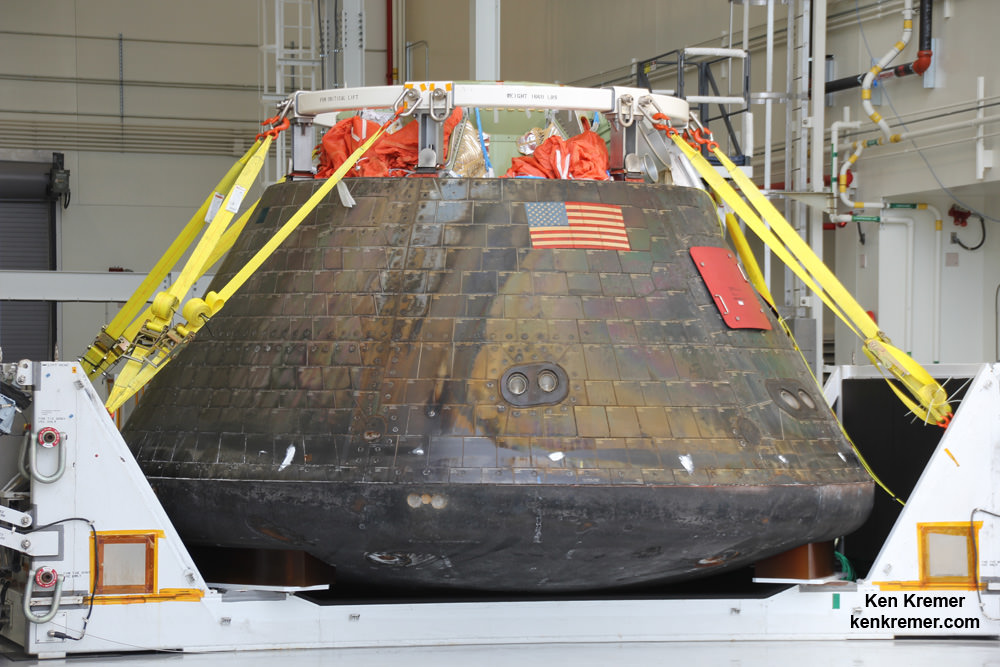
Right now NASA is building the next Orion.
If you desire to be aboard a future Orion, don’t let anything ‘Drag You Down.’
And tell Congress and the White House to ‘Support Full Funding for NASA!’ – – Because Congress has significantly slashed funding for the commercial crew capsules in the upcoming 2016 Fiscal Year budget!
Stay tuned here for Ken’s continuing Earth and planetary science and human spaceflight news.
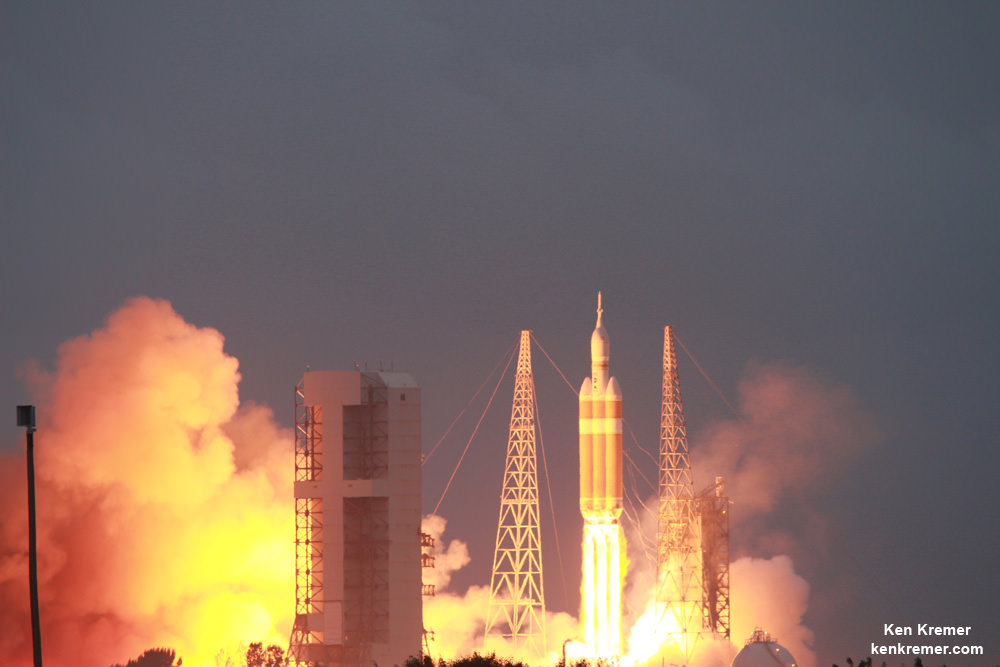
Milestone Test Firing of NASA’s SLS Monster Rocket Engine Advances Human Path to Deep Space
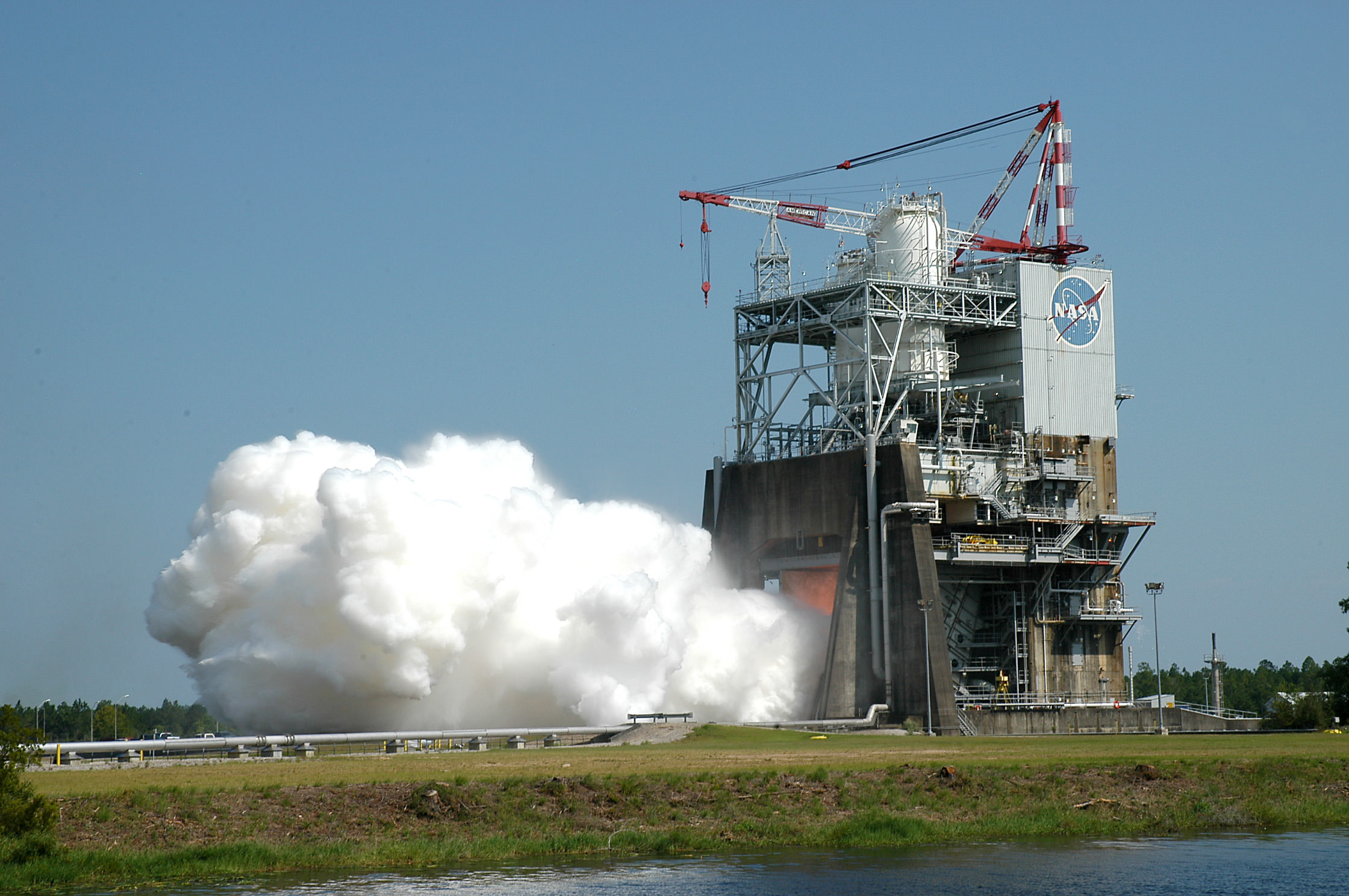
During a 535-second test on August 13, 2015, operators ran the Space Launch System (SLS) RS-25 rocket engine through a series of tests at different power levels to collect engine performance data on the A-1 test stand at NASA’s Stennis Space Center near Bay St. Louis, Mississippi. Credit: NASA
Story/imagery updated
See video below of full duration hot-fire test[/caption]
With today’s (Aug. 13) successful test firing of an RS-25 main stage engine for NASA’s Space Launch System (SLS) monster rocket currently under development, the program passed a key milestone advancing the agency on the path to propel astronauts back to deep space at the turn of the decade.
The 535 second long test firing of the RS-25 development engine was conducted on the A-1 test stand at NASA’s Stennis Space Center near Bay St. Louis, Mississippi – and ran for the planned full duration of nearly 9 minutes, matching the time they will fire during an actual SLS launch.
All indications are that the hot fire test apparently went off without a hitch, on first look.
“We ran the full duration and met all test objectives,” said Steve Wofford, SLS engine manager, on NASA TV following today’s’ test firing.
“There were no anomalies.” – based on the initial look.
The RS-25 is actually an upgraded version of former space shuttle main engines that were used with a 100% success rate during NASA’s three decade-long Space Shuttle program to propel the now retired shuttle orbiters to low Earth orbit. Those same engines are now being modified for use by the SLS.
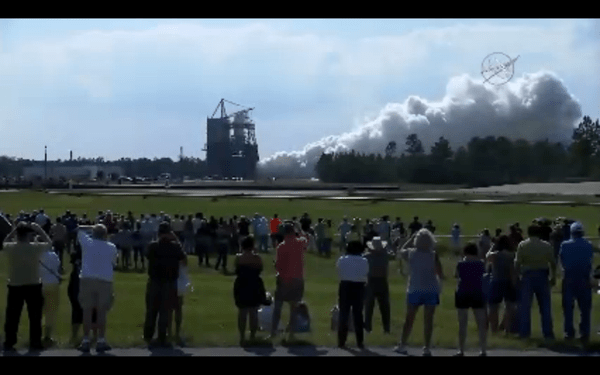
“Data collected on performance of the engine at the various power levels will aid in adapting the former space shuttle engines to the new SLS vehicle mission requirements, including development of an all-new engine controller and software,” according to NASA officials .
The engine controller functions as the “brain” of the engine, which checks engine status, maintains communication between the vehicle and the engine and relays commands back and forth.
The core stage (first stage) of the SLS will be powered by four RS-25 engines and a pair of the five-segment solid rocket boosters that will generate a combined 8.4 million pounds of liftoff thrust, making it the most powerful rocket the world has ever seen.
Since shuttle orbiters were equipped with three space shuttle main engines, the use of four RS-25s on the SLS represents another significant change that also required many modifications being thoroughly evaluated as well.
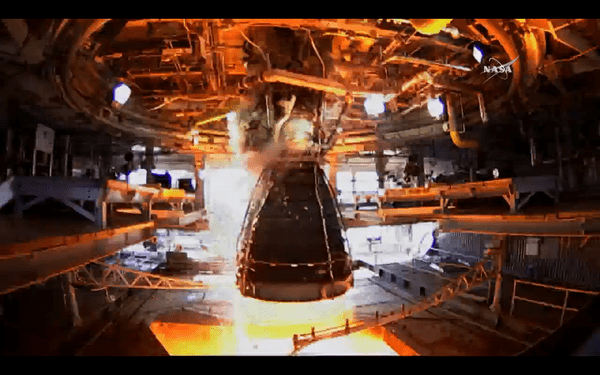
The SLS will be some 10 percent more powerful than the Saturn V rockets that propelled astronauts to the Moon, including Neil Armstrong, the human to walk on the Moon during Apollo 11 in July 1969.
SLS will loft astronauts in the Orion capsule on missions back to the Moon by around 2021, to an asteroid around 2025 and then beyond on a ‘Journey to Mars’ in the 2030s – NASA’s overriding and agency wide goal.
Each of the RS-25’s engines generates some 500,000 pounds of thrust. They are fueled by cryogenic liquid hydrogen and liquid oxygen. For SLS they will be operating at 109% of power, compared to a routine usage of 104.5% during the shuttle era. They measure 14 feet tall and 8 feet in diameter.
They have to withstand and survive temperature extremes ranging from -423 degrees F to more than 6000 degrees F.
This video shows the full duration hot-fire test:
NASA has 16 of the RS-25s leftover from the shuttle era and they are all being modified and upgraded for use by the SLS rocket.
Today’s test was the sixth in a series of seven to qualify the modified engines to flight status. The engine ignited at 5:01 p.m. EDT and reached the full thrust level of 512,000 pounds within about 5 seconds.
The hot gas was exhausted out of the nozzle at 13 times the speed of sound.
Since the shuttle engines were designed and built over three decades ago, they are being modified where possible with state of the art components to enhance performance, functionality and ease of operation, by prime contractor Aerojet-Rocketdyne of Sacramento, California.
One of the key objectives of today’s engine firing and the entire hot fire series was to test the performance of a brand new engine controller assembled with modern manufacturing techniques.
“Operators on the A-1 Test Stand at Stennis are conducting the test series to qualify an all-new engine controller and put the upgraded former space shuttle main engines through the rigorous temperature and pressure conditions they will experience during a SLS mission,” says NASA.
“The new controller, or “brain,” for the engine, which monitors engine status and communicates between the vehicle and the engine, relaying commands to the engine and transmitting data back to the vehicle. The controller also provides closed-loop management of the engine by regulating the thrust and fuel mixture ratio while monitoring the engine’s health and status.’
Video caption: RS-25 – The Ferrari of Rocket Engines explained. Credit: NASA
“The RS-25 is the most complicated rocket engine out there on the market, but that’s because it’s the Ferrari of rocket engines,” says Kathryn Crowe, RS-25 propulsion engineer.
“When you’re looking at designing a rocket engine, there are several different ways you can optimize it. You can optimize it through increasing its thrust, increasing the weight to thrust ratio, or increasing its overall efficiency and how it consumes your propellant. With this engine, they maximized all three.”
Engineers will now pour over the data collected from hundreds of data channels in great detail to thoroughly analyze the test results. They will incorporate any findings into future test firings of the RS-25s.
NASA says that testing of RS-25 flight engines is set to start later this fall.
“The RS-25 engine gives SLS a proven, high performance, affordable main propulsion system for deep space exploration. It is one of the most experienced large rocket engines in the world, with more than a million seconds of ground test and flight operations time.”
NASA plans to buy completely new sets of RS-25 engines from Aerojet-Rocketdyne taking full advantage of technological advances and modern manufacturing techniques as well as lessons learned from this hot fire series of engine tests.
The maiden test flight of the SLS is targeted for no later than November 2018 and will be configured in its initial 70-metric-ton (77-ton) version with a liftoff thrust of 8.4 million pounds. It will boost an unmanned Orion on an approximately three week long test flight beyond the Moon and back.

NASA plans to gradually upgrade the SLS to achieve an unprecedented lift capability of 130 metric tons (143 tons), enabling the more distant missions even farther into our solar system.
The first SLS test flight with the uncrewed Orion is called Exploration Mission-1 (EM-1) and will launch from Launch Complex 39-B at the Kennedy Space Center.

Orion’s inaugural mission dubbed Exploration Flight Test-1 (EFT) was successfully launched on a flawless flight on Dec. 5, 2014 atop a United Launch Alliance Delta IV Heavy rocket Space Launch Complex 37 (SLC-37) at Cape Canaveral Air Force Station in Florida.
Stay tuned here for Ken’s continuing Earth and Planetary science and human spaceflight news.
